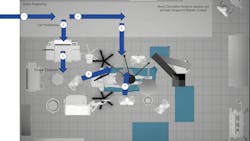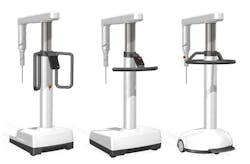At a Glance:
- The pandemic has forced remote product development in many fields, and the medical device arena has seen rapid growth in the use of virtual reality (VR).
- Studying the potential outcomes for individual designs in advance of fabrication will save both development time and manufacturing fabrication time.
- In medical device design, consideration of the operating theater and how humans and robots interact must also be part of the consideration.
The pandemic changed medical device research and development and drove conformance to an alternative usability engineering process to inform design. In-person protocols practically stopped, forcing usability evaluation methods to be primarily remote. These changes helped to drive the accelerated development of virtual reality (VR) technology in medical device design processes.
Greatly evolved by the high-volume gaming industry, VR technology has become an affordable and easy-to-use development tool. Applied readily to training, VR technology is now valuable upstream in early device development. Configuration modeling is seen as valuable because it is intended to inform system architecture, especially as it correlates to user interfaces (UI).
Getting the Study Methodology Right
This established design methodology incorporates study models that allow the user to assess, at a feature level, disparate UI configurations to inform systems engineering and industrial design before these disciplines are engaged. This complements additional system-level design inputs that could involve mechanical engineering, manufacturability, service, sustainability and power management.
While the study models are not iterations of a design direction under development, these models are considered a mock-up or prop. Such a methodology can provide a user with the way to determine their own set of alternative UI configurations and preferred features. Deliberately configured to demonstrate UI features in various ways, each model presents an alternative UI.
Differences between configurations may be as simple as one that is in portrait and one in landscape orientation. Additional examples of differentiation include features such as handles positioned at different attitudes and disposable sets being loaded from different orientations. Taking such an approach enables study participants to evaluate their preferred feature configurations by trying out numerous configurations in a simulated context of use environment, enabling them to express why certain features or configurations are favored prior to selecting a complete design solution.
Unfortunately, each study model has to be engineered in CAD for fabrication in order to provide the study participant with a sufficient level of interaction for the UI to be experienced in a meaningful way. Features that open and close, for instance, will require hinges and latches to be engineered.
Even though models are not put through an extensive design process for manufacturability, significant time is still required to engineer, fabricate and debug such features. Unfortunately, this engineering time and CAD data is considered “throwaway engineering”—not a predecessor CAD database to evolve into the eventual design direction.
However, a study model’s development time can be substantially reduced by providing a virtual means for the study participate to evaluate the study models. Evaluating virtual models eliminates the need to engineer all the mechanically functional details and the costs associated with fabrication. Rather, functions are assigned kinematic characteristics. This way, if a display (for example) is to tilt and swivel, the extent of those kinematics is defined without designing those mechanisms.
Contextual Environment Simulations
The initial investment to create a reusable environment of use is an important consideration. For instance, utilizing the fabricated methodology still means that the study would require a high-fidelity, simulated environment to be utilized for context. Depending on the device, this may be the patient’s home, the ER, the ICU, etc.
In this case study, the alternative configurations are for a surgical robot being evaluated in the contextual environment, which in this case is an operating room (OR). It is important to note that all the people and equipment involved are critical components to achieve a realistic system evaluation. For instance, it is important to incorporate all the details of the OR environment such as surgical lights, monitors, patient table, booms, IV poles, anesthesia cart, infusion pumps, etc.
Incorporating all contextual details optimizes the level of realism needed to be able to assess such parameters as footprint integration (relative to people and other equipment) to eliminate potential collisions with other equipment (maneuverability), and establish a line of sight relative to people and other equipment. The user interface layout, and determining access to the user interfaces, are also integral parts of the footprint. In addition, there are also such considerations as dimension priorities (height, width and depth), component configuration, and dynamic UI interferences or kinematics to incorporate.
Among the parameters that cannot be incorporated into a virtual study:
- Portability (center of gravity, weight, balance, etc.)
- Tactile experience (grip, comfort, etc.)
- Haptic feedback (draping, vibration, force feedback, etc.)
- Interaction with graphic user interfaces (touchscreen, keypad, etc.)
VR technology is evolving so rapidly that the interaction with the UI is starting to become feasible. In addition, augmented reality (AR), which typically encompasses combining VR technology with real-world props, has begun to address these parameters through the introduction of virtual surrogate objects that deliver the illusion as something else.
The surgical robot development example demonstrates how study participants (potential users and designers) can experience which feature layout in various configurations work best for their context of use. Using CAD, an evaluation of the robot’s impact on the context of use is inadequate, even though it is 3D.
Unfortunately, it still presents as static and is not experiential. In figure 1, while the robot seems integrated into the sterile field appropriately, the device’s kinematics are not considered, nor are the environmental context that could significantly affect usability and clinical integration. This requires adopting an interactive evaluation of configuration models.
VR configuration model development begins with CAD model development for demonstrating alternative system configurations. All the user interfaces should be represented and differing between models to show options, such as handles, power button, emergency stop, break controls, power cords and data cables (Fig. 1).
Differentiating features may not just involve user interfaces but also general architecture. They can influence use-case scenarios such as impacting the robot positioning to the OR table/patient. In addition to patient and equipment access, architecture deviations could involve the shape of the robot base or the structure of the cantilevered arm, for example. Keep in mind that models should all be rather schematic in their design in order not to bias feature preferences by the overall aesthetic.
Use-Case Scenario Planning
After modeling the digital OR environment, plan a use-case scenario, which in this case involves robotic-assisted surgery (RAS). Next, storyboard the scenario to determine what actors need interactive features, or kinematics. Since evaluating the design in context will likely reveal unintended interactions, the process will likely be iterative. Along with the storyboard (Fig. 2), there should be an associated script. This will allow the developer to adjust the environment and actor kinematics accordingly.
For example, when the robot is pushed into the room from storage, immediately note concerns due to running into the medication cart. This is solved when the cart is moved toward anesthesia away from the thoroughfare. The next action to take is to open the cart drawer to make sure there is adequate space for the anesthesiologist to conduct his procedures. After continuing to move the robot into the room, then position or dock the robot against the table, making sure it doesn’t interfere with the overhead monitor and lights. Once the line of sight from the anesthesiologist to the monitors and other personnel is checked for any potential issues, then also check the line of sight between the surgeon console to the first assist and the monitors, as well as to other personnel.
Following this script, the developer understands that the medication cart, robot, lights, monitors and patient table will require kinematic features for the RAS scenario. This is the point where participants can put on goggles and gloves to try out the experience. Make sure the room utilized is of similar size as the space the participant is to explore.
It is best to prepare and use a study guide in addition to discussion points so that the moderator is aware of when to prompt the participant for feedback and is prepared with what questions to ask. Some like having the participant use a think-aloud approach, which also is an appropriate and effective method. As the participant responds to prompts from the moderator and executes tasks, the insights regarding why one configuration is preferred over another becomes clear.
Examples of questions that could be asked include:
- Is there enough space for the surgical team to access the patient and exchange instruments with the robot?
- If the RAS converts to an open procedure, how would the team interact with the robot?
Applying VR technology to various configuration alternatives is highly effective for generating design inputs and for making better foundational system design decisions. Additionally, it results in much lighter CAD models, without requiring the need for extra engineering of mechanisms or the need for fabrication. A configuration model study presented in VR ultimately can reduce development time and costs by enabling quicker iterations.
Sean Hägen is founding principal and director of research & synthesis at BlackHägen.


